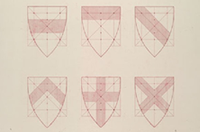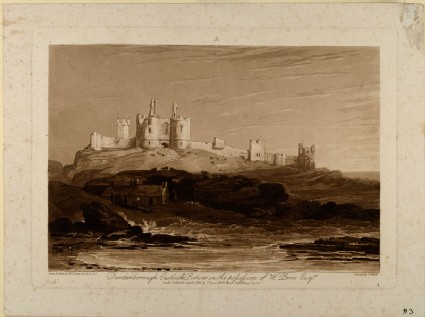Ruskin's revision to the Rudimentary series (1878)
Unpublished manuscript catalogue for proposed re-organisation of the Rudimentary series.

Ruskin's Catalogues: 1 object
Show search help- Reference URL
Actions
Dunstanborough Castle (from the Liber Studiorum) Turner
-
Ruskin text
156. Dunstanborough ?Completion of the same subject; quite one of the most characteristic pieces of our wild and impressive Northern Landscape, seen under quiet evening-light. I often wonder that Turner did not take more pains with the near sea which is curiously hard at the edges of the waves; and yet, practically, I never tire of the picture.
-
Details
- Artist/maker
-
Turner (Joseph Mallord William Turner) (1775 - 1851) (designer, etcher)Charles Turner (1773 - 1857) (engraver)
- Object type
- Material and technique
- etching and mezzotint on paper
- Dimensions
- 207 x 291 mm (plate); 253 x 338 mm (sheet)
- Associated people
-
Charles Turner (1773 - 1857) (publisher)
- Associated place
-
- Europe › United Kingdom › England › Northumberland › Craster › Dunstanburgh Castle › Dunstanburgh Castle (subject)
- Inscription
- Recto:
all within the plate mark, etched:
top centre: A
bottom left: Drawn & Etched by J.M.W. Turner Esqr. R.A. P.P.
bottom right: Engraved by C. Turner
bottom centre: Dunstanborough Castle, the Picture in the possession of W. Penn Esqr. | London Published June. 10. 1808. by C. Turner No. 50. Warren Street, Fitzroy Square
just within the plate, bottom left: Proof
bottom right, in ink: 93
Verso:
centre, the Ruskin School's stamp
just below, in ink: T.4.
centre right, a second impression of the Ruskin School's stamp
- Provenance
-
Presumably presented by John Ruskin to the Ruskin Drawing School (University of Oxford); first recorded in the Ruskin Drawing School in 1878; transferred from the Ruskin Drawing School to the Ashmolean Museum c.1949
- No. of items
- 1
- Accession no.
- WA.RS.RUD.156
-
Subject terms allocated by curators:
Subjects
-
References in which this object is cited include:
References
Finberg, Alexander J., The History of Turner's Liber Studiorum: With a New Catalogue Raisonné (London: Ernest Benn, 1924), no. 14.I
Ruskin, John, ‘Rudimentary Series 1878’, 1878, Oxford, Oxford University Archives, cat. Rudimentary no. 156
Ruskin, John, ‘The Ruskin Art Collection at Oxford: Catalogues, Notes and Instructions’, Edward T. Cook and Alexander Wedderburn, eds, The Works of John Ruskin: Library Edition, 39 (London: George Allen, 1903-1912), 21, cat. Rudimentary no. 156
Location
-
- Western Art Print Room
Ruskin's Catalogues
-
Ruskin's revision to the Rudimentary series (1878)
156. Dunstanborough ?Completion of the same subject; quite one of the most characteristic pieces of our wild and impressive Northern Landscape, seen under quiet evening-light. I often wonder that Turner did not take more pains with the near sea which is curiously hard at the edges of the waves; and yet, practically, I never tire of the picture.






